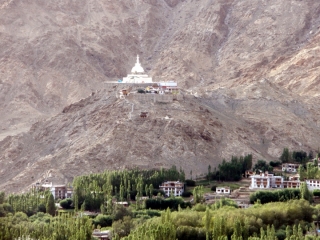Midnight, August 6, 2010: "Link, wake up! Water is coming in from the roof!" My mother and I were in Leh, Ladakh, staying at "Eco-Homestay," the house of Mr. Sonam Gyatso and family, in Lower Sankar. The house was made in a hybrid of traditional and modern construction techniques: the main hall in the house was concrete, while rooms surrounding it were made of sun-dried mud bricks, and roofed with Poplar beams, a mesh of willow branches, and a thick pad of fine clay-like mud. The house incorporated passive solar building techniques, such as a direct-gain room, and a Trombe wall, and had solar-powered lighting. It had been raining since evening, and by midnight the clay roof was saturated and began to leak.
We were in Leh for the express purpose of meeting with Helena Norberg-Hodge, the founder of the International Society for Ecology and Culture, co-founder of the International Forum on Globalization, founder of the Ladakh Ecological Development Group, and founder of the Women's Alliance, Ladakh. We had learned of her online, seeing an article of hers in CounterCurrents.org, and watching her video "Ancient Futures." She is the only person who has critically witnessed the "development" of Ladakh, from complete self-sufficiency in an exceedingly fragile eco-system, to the disaster under which it writhes today. She has seen how "development" pulls people into a money economy, increases the distance between production and consumption, brings reliance on fossil fuels (especially apparent in Leh where fuel and commodities are trucked in over a hazardous two-day journey from lower altitudes), results in urbanization and rural-urban migration, and brings psychological impoverishment to the people it is inflicted upon. For 35 years, she has been working to bring safe, stable, and ecologically sound development to the region through her organizations. Her work today, no longer limited to Ladakh, is focussed on spreading economic literacy among people throughout the planet, educating about the deeper impacts of globalization and today's consumer mono-culture. Garnered from her years of observation and research, she has an important message for humanity today, which is what prompted us to go and meet her.
Rain is more or less foreign and new to Ladakh, as are tourists. People there say that it never rained in Ladakh, though records show an insignificant average annual rainfall of less than 3.5 inches. Villages exist like oases around rivers and tributaries, the only green in the otherwise rocky, arid landscape. Geographically, Ladakh is situated in the rain shadow of the Lower Himalayan mountains. Water for drinking and irrigation in Ladakh comes from glacier melt, which was historically replenished every year by winter snowfall. Today, anyone in Ladakh — even children — can tell you their memories of large glaciers, now only tiny silver slivers on the tops of massive black mountains in the distance. Going and gone are the pure waters that came from those glaciers. Each generation, and now each year, looks toward the mountains apprehensively, watching their water supply — their life-blood — melt away.
Before bed, Stanzin Tashi, Mr. Gyatso's son, had been playing with my camera, trying to take pictures of the lightening. It was a ferocious storm, with constant, menacing thunder, and an incessant volley of lightening up and down the valley. The whole family was a little nervous, since they had never seen such a storm before. Mom and I weren't particularly worried, having experienced tropical storms in Kerala. Only later did we realize that tropical storms belong in the tropics, not the highest mountain desert of the world.
Ladakh, at an altitude of 3,500 meters, is geographically considered to be part of the Tibetan Plateau. They do have violent storms there, usually very brief and very destructive hailstorms, which come few and far-between. In the winter, there is lots of snow, and it is so cold that the schools give a three month holiday. People cluster around little stoves in the center of each room, burning wood and dung to keep warm. As shown in Helena Norberg-Hodge's book "Ancient Futures: Learning from Ladakh," (watch the movie online for free) traditional Ladakh had a completely sustainable life-style. The people were self-sufficient in all their needs: food, water, and warmth. For thousands of years, life had continued there more or less undisturbed by foreign cultures, even though the valley was a focal point for traders travelling the Silk Route, and traders from Tibet and China. Everything about life in Ladakh had a view toward the future generations; resources were shared and balanced, ensuring that they were never depleted, and the population was self-regulated to ensure enough for everyone. There were no squalid poor, no filthy rich. The people were strong, honest, and trustworthy. Only recently has all of this changed, as "modern world culture" invades and converts people to it's individual-centric, greedy, consumerist ways.
As I awoke, I noticed water pouring down the walls, and saw that the storm was still in full force. Mr. Gyatso and I went up to the roof and started bailing with a dustpan and a bucket. Gradually the rain died down, and we removed most of the standing water. By around 3 AM, the rain had subsided, the storm had moved farther down the valley, and the roof was no longer dripping; we went to sleep.
Two nights previous, Nubra (a nearby town) had suffered significant damage from a cloud burst, and radio had reported some 12 deaths. On the morning of the 6th, the radio was silent and phones unresponsive, so Mr. Gyatso went out to take stock of the situation. When he came back, he was in shock. "The BSNL office, the Bus Stand, the Hospital, everything below the [entrance to Leh] gate... all gone." That's all he could say. He had never seen anything like it, nor had anyone else in living memory. (The entrance to Leh is grandly decorated by a colorful and ornate Buddhist gate over the road, with prayer wheels and chortens on either side.) Apparently, a cloud-burst had happened in a ravine above the Leh Gate, causing a huge torrent of water to rush down the ravine into the road, picking up stones, mud, bricks, cars, people, and houses as it went. All communication channels were taken out — no electricity, no telephone, no radio, no internet.
Broken Prayers Wheels near the Leh Gate
Many of the fatalities have been blamed on poor planning: due to the mad influx of "development" to the region, many houses were built in places where, traditionally, no building should stand. We call it "tradition" and scoff at it, but in truth we are mocking a set of codes that have been developed and refined for thousands of years. A Ladakhi saying goes to the effect that "Water must have it's way," essentially, that the flow of water must not be blocked. Had this simple command been heeded, much of the destruction could have been avoided, but today's globalization pattern eschews and destroys anything and everything that doesn't fit the consumer mono-culture — it ignores the Earth upon which it stands.
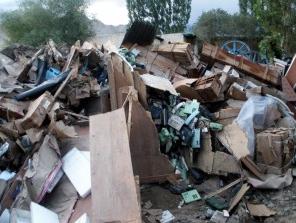
The remainder of the BSNL office
Mom immediately swung into action, and she and I headed out by 9 AM with a shovel, some water, willing hearts, and two hands each. When we got to the gate, we saw unbelivable devastation. The flood had left behind mud about a story deep, buried houses, toppled steel-and-concrete structures four stories high, crunched cars... it was much like the Tsunami of 2004 in South East Asia. Numb with shock, a crowd of people were helping a JCB (backhoe) dig at the top of the pile, looking for survivors. We helped there a bit, then continued down the hill towards the hospital. The destruction became more and more massive as we went. The air was dry, causing passing vehicles to raise clouds of dust from the now-dry mud.
We later heared opinions expressed that the traditional mud-brick construction of the majority of the houses which were destroyed was responsible for the deaths; had it been modern cement and steel, they say, the houses would have remained. On the ground, however, next to a four story cement and steel structure that had half toppled over, was a single story mud-brick house that had received the full brunt of the flow but was still standing. Not that it made a difference: people in both structures died in the deep flow of mud, but the difference in structural integrity was astonishing, and is worth taking note.
As we continued down the path that the water had taken (we were walking on the mud left behind, between four and six feet above normal ground level) we went past the municipal buildings, the location of the destroyed BSNL office, and down towards the hospital. The destructive power of fast-flowing water is amazing: bulldozers and road rollers had been piled up against a fence; four buses were smashed into the back of a building; a water tanker was driven up a satellite dish; the bus stand was cleared; Innovas, Santros, Qualis's, Sumos, all were strewn around the landscape, crushed sometimes beyond recognition; houses were wiped out without a trace. We are sure that every time we walked on that mud, we were walking over dead bodies.
Reaching the new hospital building, we joined the people working there. The construction of this three story building had been just finished, it's plumbing and electrical was almost done, and miraculously, it had survived the flood. The ground floor was full of mud about two feet deep, and patients were already being brought in from the old, single-story, mud-filled hospital. Mom went up to see what she could do in the wards, while I joined some people clearing the mud for streachers and other equipment. Another major miracle: the hospital's drug and equipment store room had been untouched, as had the only petrol pump in Leh, about 100 meters farther down.

A two or three story building, broken by the mud flow. Also note that the mud left behind is one or two stories deep (I don't know for sure, because I never saw the original state of the building).
A fire truck was positioned near the hospital, and supplied water to wash off the various pieces of equipment that were salvaged from the old wards: oxygen and nitrogen tanks, suction machines, X-Ray machines, beds, streachers, etc. Once washed, the equipment was dried and immediately put to use. After a bit, I too went to the wards, and got involved in dressing wounds. Most of the patients had full-body cuts and scrapes, about 90% of their skin scratched or missing, with head injuries, and many broken ribs.
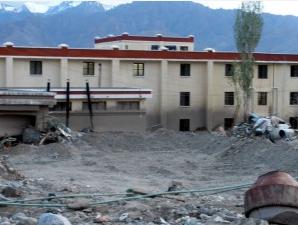
The new hospital building in Leh. Note the mud drying on the side, indicating the strength and depth of the flow.
Many of the patients were Bihari. Did you imagine that only tourists went to Ladakh? There are almost as many Bihari laborers in Leh as there are Ladakhis! Due to the economics of globalization, the poor Bihari has become the laborer for the rest of India, going to the most remote corners of the country, slaving for cash to send to his farming village, so that they can buy food that they can't grow, as their fields are filled with mono crops meant for the export market. It continues to amaze me that farmers, who produce the only truly essential commodity, are taught to see their profession as backward, and are cheated into living in the money economy as poor, starved skeletons. Squeezing the rural poor is good for the GDP, however, since it creates a large, cheap labor pool, which encourages construction, which generates investment opportunities for the rich. "To he that have shall be given, and from he that have not, shall be taken even that which he has." The "poor" ("undeveloped") had culture, now even that is being taken away by today's globalized, greed-based corporatocracy.
Choglamsar, a town about 7 kilometers down the valley from Leh, was worst hit — reports said it was mostly wiped out. For several hours that morning, army lorries were bringing up loads of dead bodies every 10 minutes, and an unfinished shopping complex was turned into a temporary morgue, after the official one, and another hall, had filled up. The bridges and roads to other villages were completely wiped out, making the only escape for tourists in those parts a three day trek. A friend of ours who had gone trekking just before the disaster told us (when she finally made it back, days later) that the Ladakhi social fabric is still sufficiently intact, despite the onslaught of modernization, that families in the town she was in were opening their guesthouses free of charge for people whose homes were destroyed. Helena Norberg-Hodge, in a message she wrote to Ladakhis at this time observed that if such hospitality could be extended throughout the region, than the huge amounts of money that is usually spent for conventional emergency relief could be saved and put to better use. What better response than a community response? Low-cost, highly efficient, localized, and personal; that is the way of the future.
From Mrs. Norberg-Hodge, we learned that in Buddhism, as in Sanathana Dharma, there is an emphasis on accepting change, part of the reason that "development," and the associated impoverishment of people has been readily accepted in Ladakh and throughout India. However, today's change is not natural, evolutionary change, it is change that is actively brought about due to an economic structure that is destroying human civilization. Globalization is truly the spread of consumerism and an economically unsound mono-culture. In her film, "The Economics of Happines," Helena Norberg-Hodge points to our common misconception of globalization, that it is about increasing international understanding and collaboration. Today's globalized economies import and export about the same amount of each commodity, creating a needless increase in transportation. Need is manufactured, and products created to fill that need, leading to a gigantic, senseless waste of resources. Helena showed us how apples in the UK were flown to South Africa for washing and waxing, and then flown back for sales. The recent shutdown due to volcanic ash in Europe demonstrated the perilous aspects of the global economy. Consumerism is exported and expounded to all parts of the planet, impoverishing truly rich, though "undeveloped" people. All of this leads to an increase in the usage (wastage?) of energy worldwide, heating our Earth, polluting our water, killing our soil. When we speak of the world's regions most vulnerable to climate change, islands and beaches top the list, but this experience in Ladakh convinces me that all places on Mother Earth are equally, and extremely, endangered.
The next two nights, the Government issued a warning, telling all people to leave their houses and congregate at higher ground, and many people went to the tops of nearby ridges. As it was, people were jumpy and nervous; several times during the day, on mere rumors, people ran up the mountainsides fearing more flooding. The shock and grief of everyone in Leh was palpable. We met many people who told us that their whole family had been washed away... The family we were staying with climbed up to the Shanti Stupa, which is built on a small rocky hillock. Both nights we got back from the hospital, they were already gone, and we had no idea that this warning was issued, so we slept in our beds, somewhat nervous, but not knowing what else to do. By God's Grace there was nothing more than mild rain!
The Shanti Stupa above Leh.
Since all roads were damaged (sections washed away, blocked by mudslides, bridges gone), the only way out was the airport. Airlines were operating extra flights out of the Leh Airport, and everyone who could was trying to get out. The embassies of various countries had requested all their people to evacuate. Any ticket was valid for any flight (if you waited in line for a free seat). As our seats were confirmed for the 12th, we decided to wait and help in the hospitals until we left. We were grateful to be useful at such a time. We took photos of the patients to show Holy Mother Amma for her blessing when we got back, and she saw them on the night of the 13th.
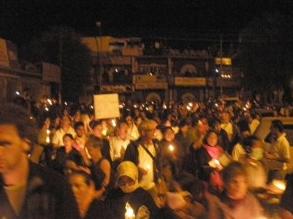
A picture of the candlelight procession on the 11th of August.
Ladakh has been an interesting case-in-point since it was opened to "modernization" in 1975. It is a microcosm of what happens to a people, culture, and ecology, when the consumer mono-culture and globalization hits it without consideration of ancient wisdoms for living with Mother Earth, and regulated intelligent development. The crises that has now hit Ladakh will, most unfortunately, hit again and again, and is not necessarily confined to Ladakh. If humankind does not learn from the increasing incidence of natural and man-made disasters, we have nothing to look forward to but mass extinction. If we seek to change our ways, the only real way to look is towards Localization — the bringing together of producer and consumer, and the creation of ethically-oriented communities, not to be confused with backwardness and isolationism. We need to think globally, and live locally, if we seek genuine development —true globalization.
On the 11th night, the Ladakh Buddhist Association (LBA) organized a candle light march from the petrol pump at the bottom of the hill to the LBA grounds in the Leh Market, in prayerful support of the people affected. (A small video is available at: https://www.youtube.com/watch?v=M3ltr2lDiHg) Vehicles were stopped to limit the dust, but the wind blasted everyone with it anyway. Going down to the hospital before it started, clouds were gathering quite menacingly at the head of the valley, and it looked as if it was raining heavily in the next valley over, causing no slight misgivings among all the people! We bid farewell to all our friends in the hospital, and joined the march by the Leh gate. Angmo-le, Mr. Gyatso's wife, was with us and sang a beautiful Buddhist chant as we went, as did many other groups. The procession culminated at the top of Market Road, placing all the candles in a circle, with everyone's individual prayers for peace and harmony.
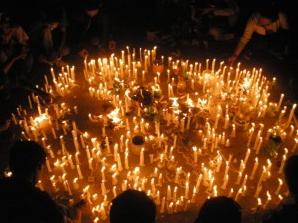
The End of the Procession
Video of the Candlelight Procession
The following morning we flew out of the valley, over the majestic mountains, and down into Delhi. Personally, I was quite sad to leave the mountains; they are so beautiful and make easy a constant recall of the great power of God.
The tremendous loss of life in Ladakh is clearly a direct result of climate change, which in turn, is a direct result of the spread of economic globalization and with it the energy-intensive human and agricultural monoculture. As we are all aware, the floods that started in Ladakh continued down the Indus River, now displacing 13 million people in Pakistan. Submerging much of the Sindh area, it has become the biggest natural disaster in recent history. We were grateful to be able to render practical support and service to the great people of Ladakh, and pray that humans return to a loving and respectful relationship to each other and to Mother Earth, before it is too late.
It's good not to be a tourist, it's much more real to be family.
- Much of the information in this article has been gained from our interactions with Helena Norberg-Hodge.
- See also: "Ancient Futures: Learning from Ladakh" by Helena Norberg-Hodge, and www.TheEconomicsOfHappiness.org
Cross-Posted at: WhatsWithTheClimate.org

